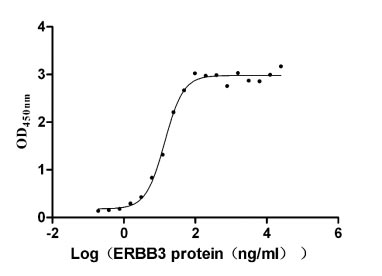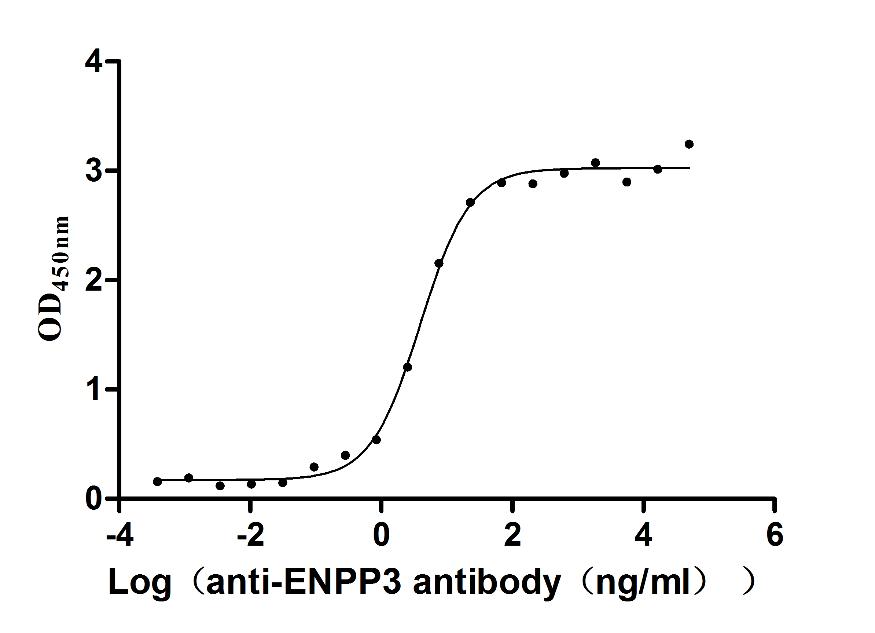Recombinant Human Transferrin receptor protein 2 (TFR2), partial
-
中文名称:人TFR2重组蛋白
-
货号:CSB-YP891794HU
-
规格:
-
来源:Yeast
-
其他:
-
中文名称:人TFR2重组蛋白
-
货号:CSB-EP891794HU
-
规格:
-
来源:E.coli
-
其他:
-
中文名称:人TFR2重组蛋白
-
货号:CSB-EP891794HU-B
-
规格:
-
来源:E.coli
-
共轭:Avi-tag Biotinylated
E. coli biotin ligase (BirA) is highly specific in covalently attaching biotin to the 15 amino acid AviTag peptide. This recombinant protein was biotinylated in vivo by AviTag-BirA technology, which method is BriA catalyzes amide linkage between the biotin and the specific lysine of the AviTag.
-
其他:
-
中文名称:人TFR2重组蛋白
-
货号:CSB-BP891794HU
-
规格:
-
来源:Baculovirus
-
其他:
-
中文名称:人TFR2重组蛋白
-
货号:CSB-MP891794HU
-
规格:
-
来源:Mammalian cell
-
其他:
产品详情
-
纯度:>85% (SDS-PAGE)
-
基因名:TFR2
-
Uniprot No.:
-
别名:HFE 3; HFE3; MGC126368; TFR 2; TfR2; TFR2_HUMAN; TFRC 2; TFRC2; Transferrin receptor 2; Transferrin receptor protein 2
-
种属:Homo sapiens (Human)
-
蛋白长度:Partial
-
蛋白标签:Tag type will be determined during the manufacturing process.
The tag type will be determined during production process. If you have specified tag type, please tell us and we will develop the specified tag preferentially. -
产品提供形式:Lyophilized powder
Note: We will preferentially ship the format that we have in stock, however, if you have any special requirement for the format, please remark your requirement when placing the order, we will prepare according to your demand. -
复溶:We recommend that this vial be briefly centrifuged prior to opening to bring the contents to the bottom. Please reconstitute protein in deionized sterile water to a concentration of 0.1-1.0 mg/mL.We recommend to add 5-50% of glycerol (final concentration) and aliquot for long-term storage at -20℃/-80℃. Our default final concentration of glycerol is 50%. Customers could use it as reference.
-
储存条件:Store at -20°C/-80°C upon receipt, aliquoting is necessary for mutiple use. Avoid repeated freeze-thaw cycles.
-
保质期:The shelf life is related to many factors, storage state, buffer ingredients, storage temperature and the stability of the protein itself.
Generally, the shelf life of liquid form is 6 months at -20°C/-80°C. The shelf life of lyophilized form is 12 months at -20°C/-80°C. -
货期:Delivery time may differ from different purchasing way or location, please kindly consult your local distributors for specific delivery time.Note: All of our proteins are default shipped with normal blue ice packs, if you request to ship with dry ice, please communicate with us in advance and extra fees will be charged.
-
注意事项:Repeated freezing and thawing is not recommended. Store working aliquots at 4°C for up to one week.
-
Datasheet :Please contact us to get it.
相关产品
靶点详情
-
功能:Mediates cellular uptake of transferrin-bound iron in a non-iron dependent manner. May be involved in iron metabolism, hepatocyte function and erythrocyte differentiation.
-
基因功能参考文献:
- In agreement with previous studies with truncated forms of these receptors, holo-Tf binds to the TfR1 homologue significantly stronger than to TfR2. PMID: 29388418
- s retrospectively investigated whether TFR2 isoforms and EPOR are differentially expressed in MDS patients and whether the expression is associated with patients' clinical outcomes. PMID: 26914246
- unreported iron metabolism-related genes in non-classic hereditary hemochromatosis patients that were predicted to be potentially pathogenic were three novel mutations in TFR2 [two missense (p.Leu750Pro and p.Ala777Val) and one intronic splicing mutation (c.967-1G>C)], one missense mutation in HFE (p.Tyr230Cys), and one mutation in the 5'-UTR of HAMP gene (c.-25G>A) PMID: 27667161
- TFR2 expression altered within 4h of HAMP treatment, while HFE expression altered later at 24h and 48h, suggesting that TFR2 may function prior to HFE in HAMP regulation. PMID: 27667164
- Of the non-HFE forms of iron overload, TFR2-, HFE2-, and HAMP-related forms are predicted to be rare, with pathogenic allele frequencies in the range of 0.00007 to 0.0005. Significantly, SLC40A1 variants that have been previously associated with autosomal-dominant ferroportin disease were identified in several populations (pathogenic allele frequency 0.0004), being most prevalent among Africans PMID: 26633544
- Transferrin facilitates the formation of DNA double-strand breaks (DNA-DSBs) via transferrin receptor TfR1 but not TfR2. PMID: 26549031
- In line with a status of iron deficiency, gene expression studies suggested decreased expression of transferrin and transferrin receptor 2 in non-alcoholic steatohepatitis livers PMID: 25000850
- Our results indicate that membrane transferrin receptor-2, a sensor of circulating iron, is released from the cell membrane in iron deficiency. PMID: 25637053
- results suggest that down-regulation of CD81 by GRAIL targets TfR2 for degradation PMID: 25635054
- Polymorphisms of the TRF2 gene may be associated with age-related macular degeneration occurrence, either directly or by modulation of risk factors. PMID: 24648608
- The variants of rs2075674 and rs7385804 in TFR2 gene were not associated with coronary heart disease risk in a Chinese Han population. PMID: 23751596
- Present findings support the hypothesis of a main role of the TFR2 gene in HH pathogenesis in those regions, such as Central-Southern Italy, where the p.C282Y frequency is low. PMID: 24055163
- s investigated the expression of TfR1 and TfR2 in human HCC tissues by immunohistochemistry, the first report demonstrating TfR2 expression immunohistochemically in human HCC. PMID: 24901155
- N-linked glycosylation is dispensable for the cell surface expression and holo-Tf binding, but it is required for efficient intersubunit disulfide bond formation and holo-Tf-induced stabilization of TfR2. PMID: 23556518
- The hemochromatosis proteins HFE, TfR2, and HJV form a membrane-associated protein complex for hepcidin regulation. PMID: 22728873
- Mutations in the TFR2 gene is associated with hemochromatosis. PMID: 22890139
- Data sugggest that TfR-lytic peptide might provide a potent and selective anticancer therapy for patients. PMID: 21849092
- TfR2 mRNA expression in hyperplastic anemia patients increases and closely correlates with hyperplasia status of bone marrow and anemia level in peripheral blood. PMID: 21518504
- rs4820268 variant of TFR2 gene is involved in the regulation of serum iron levels. PMID: 21208937
- Data show that ULBP1, TFR2 and IFITM1 were associated with increased susceptibility to Vgamma9Vdelta2 T-cell cytotoxicity. PMID: 20220060
- None of the individuals in this cohort of Brazilian patients with the classical phenotype of HH had any of the aforementioned non-C282Y mutations in the HFE gene or any mutations in the TfR2 and SCL40A1 genes. PMID: 19759876
- findings show that HFE is present in substoichiometric concentrations with respect to both TfR1 and TfR2 in liver tissue; finding supports a model, in which availability of HFE is limiting for formation of complexes with TfR1 or TfR2 PMID: 19819738
- Hepcidin mRNA expression in vitro is highly sensitive to the presence of serum factors and PI3 kinase inhibition and parallels TfR2 expression PMID: 19924283
- Relative expression level of TFR2 mRNA in prednisone good responders was significantly higher than that in prednisone poor responders in children with acute leukemia. PMID: 19292036
- identification of a novel TfR2 mutation in a cohort of non-C282Y iron overload patients of mixed ethnic backgrounds PMID: 12130528
- TFR2 maps to chromosome 7. It is an alternately spliced protein and lacks the entire transmembrane and cytoplasmic domains. PMID: 12139409
- production of anti-TFR2 monoclonal antibodies, their characterization, and their use to study TFR2 tissue distribution and up-regulation in response to TF-bound iron PMID: 12393650
- TfR2 protein levels are approximately 20-fold lower than TfR in erythroid/myeloid cells. TfR & TfR2 have similar cellular localizations in K562 cells & coimmunoprecipitate to only a limited extent. Under nonreducing conditions, they can form heterodimers. PMID: 12406888
- Expression of HFE and TfR2 proteins in human platelets may indicate that the mutations in the corresponding genes could influence platelet count, size and/or activation. suggests that HFE may serve a different function in platelets. PMID: 12656741
- unlike TfR1, which recycles apo-Tf back to the cell surface after the release of iron, TfR2 promotes the intracellular deposition of ligand. PMID: 15317665
- TfR2 acts as a sensor of iron status such that receptor levels reflect transferrin saturation. PMID: 15319276
- Has a role monitoring iron levels by sensing changes in the concentration of diferric transferrin. PMID: 15319290
- Urinary hepcidin is low or undetectable in 8 of 10 hemochromatosis cases irrespective of previous phlebotomy treatments, confirming the proposed role of TFR2 as a regulator of hepcidin production. PMID: 15486069
- TfR2 plays a role in the pathogenesis of hemochromatosis in Japan. PMID: 15749661
- HFE and TFR2 interact in cells; this interaction is not abrogated by disease-associated mutations of HFE and TFR2; and that TFR2 competes with TFR1 for binding to HFE PMID: 16893896
- hemojuvelin and TfR2 were predominantly localized to the basolateral membrane domain of hepatocytes; localization of Hjv and TfR2 at the same membrane domain renders a functional interaction of these two proteins in iron homeostasis possible PMID: 16932966
- Mutational analysis of TfR2 shows that the mutation G679A, which blocks TfR2 binding to diferric transferrin Fe(2)Tf, increases the rate of receptor turnover and prevents stabilization by Fe(2)Tf. PMID: 17182845
- although holo-Tf binding to the ectodomain is necessary, the cytoplasmic domain of TfR2 is largely responsible for its stabilization by holo-Tf. PMID: 17202145
- the TfR2/HFE and TfR1/HFE interactions are distinct. PMID: 17956864
- Transferrin receptor 2 mediates transferrin-bound iron uptake by receptor-mediated endocytosis. PMID: 18083267
- co-expression of HFE in cells expressing TfR2 led to increased affinity for diferric transferrin, increased transferrin-dependent iron uptake, and relative resistance to iron chelation PMID: 18353247
- analysis of early-onset haemochromatosis caused by a novel combination of TFR2 mutations [case report] PMID: 18450729
- TfR2 expression can be modulated through stimuli similar to those known to act on TfR1 and these findings may have important implications for our understanding of the role of TfR2 in the regulation of iron homeostasis. PMID: 19019709
- In colon cancer cell lines, TfR2 is localized in membrane lipid rafts, induces ERK1/ERK2 phosphorylation, and is preferentially expressed during S-M phases of the cell cycle. PMID: 19729324
- identified mutations in HFE, SLC40A1, HAMP, HJV, TFR2, and FTL that could explain TRANSFERRIN SATURATION/SERUM FERRITIN heterogeneity in adults with previous HFE genotyping to detect C282Y and H63D; results were correlated with racial groups PMID: 19787796
- Mice were created that are homozygous for a mutation that is orthologous to the Y250X mutation identified in some patients with hereditary hemochromatosis type 3. The mutant mice showed profound abnormalities in parameters of iron homeostasis. PMID: 12134060
显示更多
收起更多
-
相关疾病:Hemochromatosis 3 (HFE3)
-
亚细胞定位:Cell membrane; Single-pass type II membrane protein.; [Isoform Beta]: Cytoplasm. Note=Lacks the transmembrane domain. Probably intracellular.
-
蛋白家族:Peptidase M28 family, M28B subfamily
-
组织特异性:Predominantly expressed in liver. While the alpha form is also expressed in spleen, lung, muscle, prostate and peripheral blood mononuclear cells, the beta form is expressed in all tissues tested, albeit weakly.
-
数据库链接:
HGNC: 11762
OMIM: 604250
KEGG: hsa:7036
STRING: 9606.ENSP00000223051
UniGene: Hs.544932
Most popular with customers
-
Recombinant Human Receptor tyrosine-protein kinase erbB-3 (ERBB3), partial (Active)
Express system: Mammalian cell
Species: Homo sapiens (Human)
-
Recombinant Human Somatostatin receptor type 2 (SSTR2)-VLPs (Active)
Express system: Mammalian cell
Species: Homo sapiens (Human)
-
Express system: Mammalian cell
Species: Macaca fascicularis (Crab-eating macaque) (Cynomolgus monkey)
-
Recombinant Human Mucin-17 (MUC17), partial (Active)
Express system: Mammalian cell
Species: Homo sapiens (Human)
-
Recombinant Human Desmoglein-3 (DSG3), partial (Active)
Express system: Baculovirus
Species: Homo sapiens (Human)

















